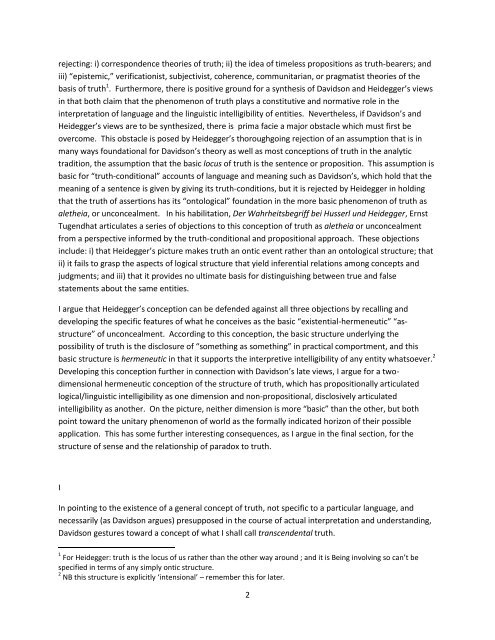Heidegger, Tugendhat, Davidson - University of New Mexico
Heidegger, Tugendhat, Davidson - University of New Mexico
Heidegger, Tugendhat, Davidson - University of New Mexico
You also want an ePaper? Increase the reach of your titles
YUMPU automatically turns print PDFs into web optimized ePapers that Google loves.
ejecting: i) correspondence theories <strong>of</strong> truth; ii) the idea <strong>of</strong> timeless propositions as truth-bearers; and<br />
iii) “epistemic,” verificationist, subjectivist, coherence, communitarian, or pragmatist theories <strong>of</strong> the<br />
basis <strong>of</strong> truth 1 . Furthermore, there is positive ground for a synthesis <strong>of</strong> <strong>Davidson</strong> and <strong>Heidegger</strong>’s views<br />
in that both claim that the phenomenon <strong>of</strong> truth plays a constitutive and normative role in the<br />
interpretation <strong>of</strong> language and the linguistic intelligibility <strong>of</strong> entities. Nevertheless, if <strong>Davidson</strong>’s and<br />
<strong>Heidegger</strong>’s views are to be synthesized, there is prima facie a major obstacle which must first be<br />
overcome. This obstacle is posed by <strong>Heidegger</strong>’s thoroughgoing rejection <strong>of</strong> an assumption that is in<br />
many ways foundational for <strong>Davidson</strong>’s theory as well as most conceptions <strong>of</strong> truth in the analytic<br />
tradition, the assumption that the basic locus <strong>of</strong> truth is the sentence or proposition. This assumption is<br />
basic for “truth-conditional” accounts <strong>of</strong> language and meaning such as <strong>Davidson</strong>’s, which hold that the<br />
meaning <strong>of</strong> a sentence is given by giving its truth-conditions, but it is rejected by <strong>Heidegger</strong> in holding<br />
that the truth <strong>of</strong> assertions has its “ontological” foundation in the more basic phenomenon <strong>of</strong> truth as<br />
aletheia, or unconcealment. In his habilitation, Der Wahrheitsbegriff bei Husserl und <strong>Heidegger</strong>, Ernst<br />
<strong>Tugendhat</strong> articulates a series <strong>of</strong> objections to this conception <strong>of</strong> truth as aletheia or unconcealment<br />
from a perspective informed by the truth-conditional and propositional approach. These objections<br />
include: i) that <strong>Heidegger</strong>’s picture makes truth an ontic event rather than an ontological structure; that<br />
ii) it fails to grasp the aspects <strong>of</strong> logical structure that yield inferential relations among concepts and<br />
judgments; and iii) that it provides no ultimate basis for distinguishing between true and false<br />
statements about the same entities.<br />
I argue that <strong>Heidegger</strong>’s conception can be defended against all three objections by recalling and<br />
developing the specific features <strong>of</strong> what he conceives as the basic “existential-hermeneutic” “asstructure”<br />
<strong>of</strong> unconcealment. According to this conception, the basic structure underlying the<br />
possibility <strong>of</strong> truth is the disclosure <strong>of</strong> “something as something” in practical comportment, and this<br />
basic structure is hermeneutic in that it supports the interpretive intelligibility <strong>of</strong> any entity whatsoever. 2<br />
Developing this conception further in connection with <strong>Davidson</strong>’s late views, I argue for a twodimensional<br />
hermeneutic conception <strong>of</strong> the structure <strong>of</strong> truth, which has propositionally articulated<br />
logical/linguistic intelligibility as one dimension and non-propositional, disclosively articulated<br />
intelligibility as another. On the picture, neither dimension is more “basic” than the other, but both<br />
point toward the unitary phenomenon <strong>of</strong> world as the formally indicated horizon <strong>of</strong> their possible<br />
application. This has some further interesting consequences, as I argue in the final section, for the<br />
structure <strong>of</strong> sense and the relationship <strong>of</strong> paradox to truth.<br />
I<br />
In pointing to the existence <strong>of</strong> a general concept <strong>of</strong> truth, not specific to a particular language, and<br />
necessarily (as <strong>Davidson</strong> argues) presupposed in the course <strong>of</strong> actual interpretation and understanding,<br />
<strong>Davidson</strong> gestures toward a concept <strong>of</strong> what I shall call transcendental truth.<br />
1 For <strong>Heidegger</strong>: truth is the locus <strong>of</strong> us rather than the other way around ; and it is Being involving so can’t be<br />
specified in terms <strong>of</strong> any simply ontic structure.<br />
2 NB this structure is explicitly ‘intensional’ – remember this for later.<br />
2
















